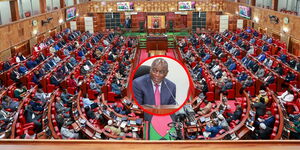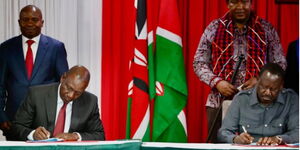Kenya’s escalating debt crisis has reached alarming proportions, with the latest figures revealing a staggering expenditure of Ksh750.51 billion on interest payments alone for the financial year 2023-2024. The Controller of Budget’s new report paints a stark picture of the nation's mounting financial obligations, highlighting a total debt expenditure of Ksh1.59 trillion.
To put this amount into perspective, it is nearly double the amount of money counties were allocated in equitable revenue share in the financial year. The government allocated Ksh385.42 billion to counties last year.
Why it matters: Rising debt costs are significantly straining Kenya’s budget, diverting funds away from essential development projects. As interest payments consume a larger share of the budget, there is less available for investment in infrastructure, education, and health, hindering long-term growth.
For businesses and households, high borrowing costs have broader repercussions. Elevated interest rates on government securities incentivise banks to invest in risk-free bonds rather than lending to enterprises. This shift restricts access to capital for businesses, stifling their growth potential and limiting job creation.
Moreover, excessive debt repayments could push the government towards default if resources are insufficient. Such a scenario could trigger severe economic instability, mirroring concerns seen in other African nations facing debt distress.
Dig deeper: The report highlights a substantial increase in debt-related spending compared to the previous year. Government expenditure on debt has surged by Ksh44 billion from the fiscal year 2022-2023, reflecting a growing financial strain. According to Margaret Nyakang’o, the Controller of Budget, this rise is primarily due to heightened domestic debt payments, which have incurred higher interest costs than external debt.
The breakdown of the Ksh1.59 trillion expenditure includes Ksh834.85 billion allocated for principal redemption and Ksh750.51 billion for interest payments. Additionally, Ksh1.58 billion was spent on commitment fees, while Ksh361.71 million covered various other charges.
Notably, the expenditure on domestic debt alone was Ksh830.22 billion, with Ksh534.22 billion dedicated to interest payments and Ksh296.01 billion towards principal redemption.
Nyakang’o’s report indicates that domestic debt servicing has become increasingly expensive due to high-interest rates on government securities. These securities have attracted substantial investment from commercial banks and other investors, drawn by their appealing returns and minimal risk. In contrast, the cost of servicing external debt remains relatively lower.
The financial strain is further compounded by recent revelations from the Auditor General, Nancy Gathungu. Her report discloses that Kenya paid Ksh1.44 billion in interest on foreign loans that have yet to be disbursed. These commitment fees pertain to undrawn portions of loans, signifying funds that the government has secured but not yet accessed.
As of June 2024, Kenya’s domestic debt stock has climbed to Ksh5.41 trillion, up from Ksh4.83 trillion the previous year. This surge surpasses the Treasury’s target of Ksh851 billion for domestic borrowing. The increase in domestic debt underscores the government’s reliance on internal borrowing to meet its financial obligations, placing additional pressure on the nation’s fiscal stability.
Amid these mounting financial pressures, President William Ruto continues to seek further borrowing from China, raising concerns about the long-term sustainability of Kenya’s debt strategy. Critics argue that the growing debt burden could impede the country’s economic development and exacerbate existing financial challenges.












